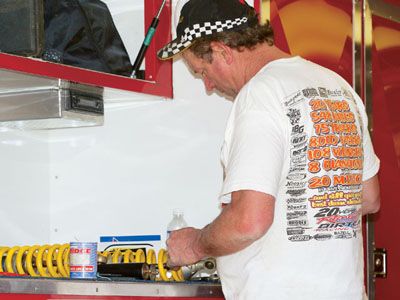
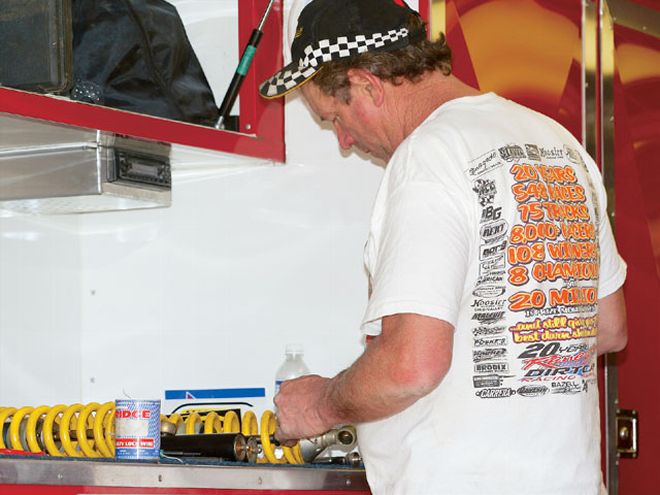 Racers such as dirt Late Model star John Mason have embraced the racing technology. With the changing conditions on dirt, the winning driver keeps extensive notes of the shock combinations needed and makes the changes accordingly.
Racers such as dirt Late Model star John Mason have embraced the racing technology. With the changing conditions on dirt, the winning driver keeps extensive notes of the shock combinations needed and makes the changes accordingly.
We asked some leading shock technicians in the industry pointed questions about how shocks rank among today's racers. The answers may surprise you.
"I had a guy call up about a month ago that was looking for certain force numbers for compression and rebound at 1 inch per second. He told me what he was trying to do, and I totally agreed on his approach. I was very impressed with his knowledge of how shocks affected his car, especially when he told me it was only his first year in a Street Stock."-Nate Thiesse, QA1/Carrera Shocks
In just the last year, racers on dirt and asphalt have dramatically changed the way they set up their cars. New directions are being explored, and with the associated changes come a whole new way of using the racing shock to fine-tune those setups. Knowing these trends were developing and that the top shock companies must be taking notes, we decided to speak with some shock gurus and see what was up. Here's what they had to say.
Do you think there is more awareness of the value of tuning with shocks among today's racers? All of the respondents answered "yes" to this question, as evidenced by the opening statement by Nate Thiesse.
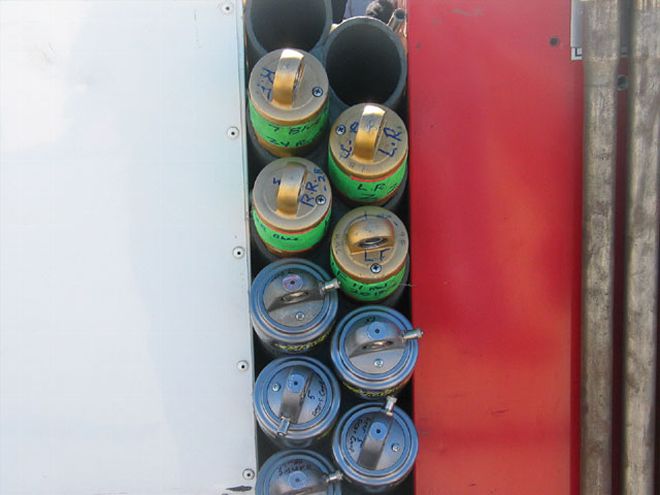 When you're racing, you need to have the right combination to win. Understanding your shocks and getting the right ones for the circumstance separates the winners from the rest of the pack.
When you're racing, you need to have the right combination to win. Understanding your shocks and getting the right ones for the circumstance separates the winners from the rest of the pack.
"Absolutely, you cannot pick up a racing magazine or watch a race on TV without seeing something about shocks," says Bill Workman with Afco Shocks.
Jeff Reid with hlins Shocks tells us, "Many racers are still not using it to full advantage. Shocks are not a cure-all for race car handling problems. The basic setup has to be good, but once the basics are right, shocks can make the difference between First and Second."
Overall, we see the average racer becoming more and more educated on how his or her car works. Do you agree, and if so, can you share some examples of this? "Yes, through racing schools and seminars, books and videos, manufacturers' tech services, computer programs, and the Internet," offers George Gillespie of Pro Shocks.
Scott Keyser with Integra Shocks, a division of Port City Racing, tells us, "The cars are more equal now than ever before. Winning today comes down to adjustability. The teams who master how to adjust their cars will have the advantage over those who do not."
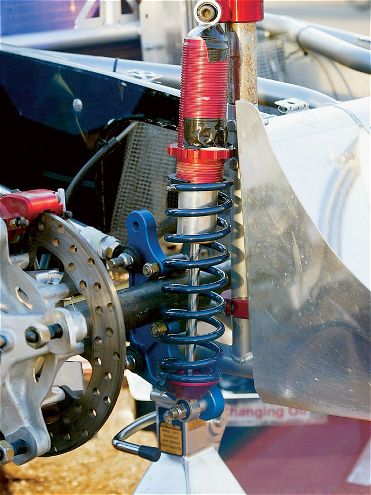 The shock sits as one component in the entire suspension system. Understanding the role of the racing shock is critical. You need to know what effects are felt with shock changes and how it impacts the entire package.
The shock sits as one component in the entire suspension system. Understanding the role of the racing shock is critical. You need to know what effects are felt with shock changes and how it impacts the entire package.
"They have to be [more knowledgeable]," says Reid. "The sport is way too competitive, and as the teams at the top levels of the sport refine and advance their knowledge of how and why a car works, there will always be a filtering down of that knowledge. Information from books and magazines like Circle Track are helping. Now teams want to know what shocks they are bolting on and are starting to look at dyno curves and making the selections themselves."
What are the current trends in shock design related to dirt racing and asphalt racing? "The gas pressure shocks are gaining more acceptance in the dirt marketplace," says Workman. "We have been able to reduce the rod pressure as well as offer the valving style that dirt cars like, and the racers are getting more comfortable with them."
Gillespie agrees: "We are seeing more high gas pressure shocks on dirt. Racers recognize that they need non-high pressure shocks for low-traction type [slick] racetrack conditions."
"Racers want to control entry," offers Keyser, "and the mono-tube shock helps. How? With gas pressure to control compression. The shocks can be made to be position-sensitive to work in defined areas of movement."
"Asphalt racers are surprisingly getting away from the usage of high gas pressure shocks," says Gillespie. "They are going to low-pressure type shocks with a better front tie-down package [higher rebound] without sacrificing traction."
"The use of aggressive rebound packages on the front, also called big nose, or stiff low-speed shocks, is becoming more popular now with the big bar, soft spring asphalt setups," says Workman.
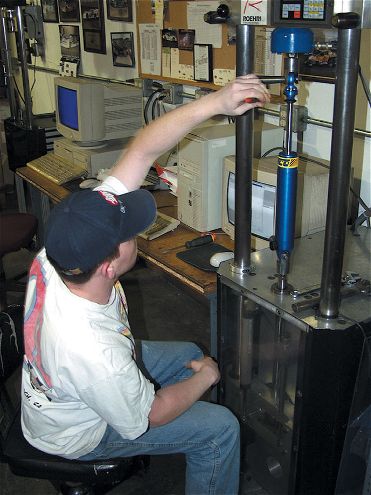 The shock dyno has become a valuable tool. It has become affordable for many racers, but some companies offer at-track service at major racing events, with qualified technicians ready to assist.
The shock dyno has become a valuable tool. It has become affordable for many racers, but some companies offer at-track service at major racing events, with qualified technicians ready to assist.
Are racers opting now, more than ever, for more expensive, adjustable shocks? Thiesse states, "Racers are gaining knowledge and experience on how the adjustments affect their chassis, and hence are more willing to spend the money for this adjustment capability."
"Absolutely," says Reid. "It doesn't take long to figure out one high-quality, adjustable shock can take the place of a boxload of nonadjustable, nonrebuildable, or nonrepairable shocks. As teams become more sophisticated in chassis tuning, they'll want to make a small adjustment in compression or rebound that can make a big difference in tire life throughout a race distance that would have been impossible, or at best awkward, without an adjustable shock."
"Yes, mainly due to less and less practice time, racers are looking for quicker adjustments to maximize their practice time," offers Gillespie.
"If it is in a racer's budget, they will always opt for adjustable shocks, and even the budget guys realize it is money well spent," Workman says of the feedback he gets from the teams.
"Yes," says Scott Keyser, "I believe they are, and that could be a good thing as long as they fully understand beforehand how to properly use them."
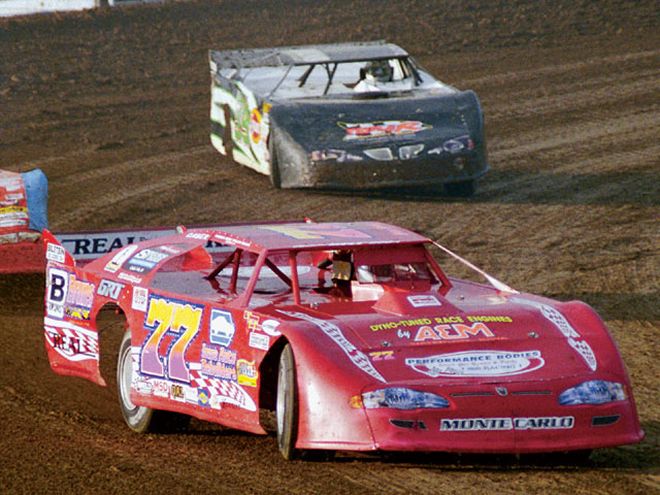 The work of the shock can be translated into simple performance. If the car is set up with the complete package that is right for the conditions, the results will reflect that.
The work of the shock can be translated into simple performance. If the car is set up with the complete package that is right for the conditions, the results will reflect that.
With the trend of having more adjustment available in shocks, have the racers become comfortable with that technology so they can properly use what is offered? "Yes, and it also means that shock dynos are more readily available to the racer," says Workman.
"Some yes and some no," Keyser notes, "and the shock dyno has definitely helped many racers to understand how a shock works and what effect the adjustments have."
Gillespie believes about 30 percent of racers are knowledgeable and 70 percent are still learning, while Reid says racers are not comfortable with the technology, but they are in the process of adapting to it. "Some are still afraid to turn the knobs for fear of losing what they know works," Reid states. "I think that comes from the inconsistency of some of the shocks they might have used in the past. We always encourage teams to 'survey the clickers'-and that is to turn the knobs and see what happens. It's a good way to get a feel for what is happening when you turn the knobs."
In simple terms, Thiesse says, "Tuning the shock to the track surface takes a well-balanced combination of understanding the adjustments the shock has and how these adjustments will affect the chassis on the track."
some top dirt Late model car builders believe most gains can be made by proper shock selection. In touring Late Model divisions, do the top teams seem more interested in high end shocks? "Yes, all of the top teams have the fully adjustable twin-tube and mono-tube shocks ready at all times," notes Workman.
Reid agrees: "Yes, it only makes sense that they would be arriving at that conclusion; as basic chassis designs and layouts become more evolved, there are fewer and fewer gains to be had in that area. The next obvious source for research and significant improvements is shock absorbers."
Agreeing with those statements, Thiesse adds, "The top teams today are so competitive that they have to take advantage of every opportunity to gain a slight edge over their competition. The more expensive shocks typically have tighter tolerances, meaning improved performance along with the ability to make an external adjustment in a matter of seconds."
Gillespie offers a slightly different opinion. "Yes," he says, "but are they necessary? No! The shock is only one part of the tuning equation."
With new trends such as the big bar and soft spring setups now used on asphalt, and the more flat running attitude of the dirt Late Models, have adjustable shocks helped the teams better tune these setups? Can the shocks of today complement the popular softer spring setups in both dirt and asphalt? "It is much easier to tune the chassis to the racetrack by using some of the advancements now available," says Keyser.
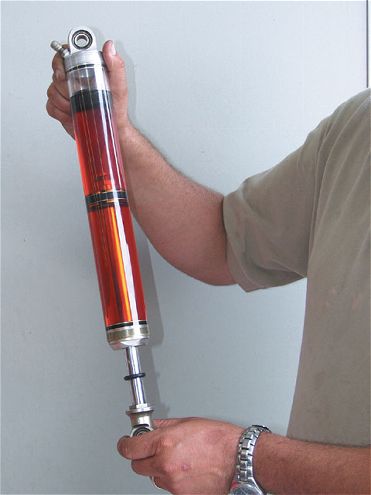
Workman concurs: "Yes, in fact, they have become almost a necessity."
In Thiesse's words, "Teams are able to fine-tune their low speed numbers more easily, therefore getting the most potential out of their chassis."
Reid continues that thought with the following: "Yes, it's all about grip, body control, and bump control. With less expensive, simpler shocks, you are always compromising between 'stiff enough' for body control without being overly stiff for the big bumps, or 'soft enough' for good grip and having no control for anything else. A modern racing shock can allow for optimization of all of these areas without sacrificing one for the other."
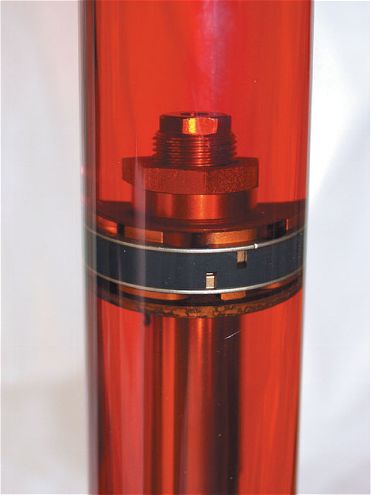 These pictures show the inner workings of a gas pressure shock. Moving the shaft up and down, simulating movement during racing, gives the novice racer a better understanding of the inner workings. It's simple science, not voodoo magic.
These pictures show the inner workings of a gas pressure shock. Moving the shaft up and down, simulating movement during racing, gives the novice racer a better understanding of the inner workings. It's simple science, not voodoo magic.
Have teams transitioned away from the traditional ways of crutching bad setups with shocks, such as using a stiff LR shock rebound to help the car turn into the corner? "No, not completely, at least," says Reid. "Sure, the better teams have, but you'll still see plenty of the 'crutch factor' among the smaller teams. Having said that, in a pinch, you have to do what you have to do to get a balanced car. All of the theories are no good if you can't get a balance, and in that case even the best might throw a 'crutch' at one end or the other now and then."
Keyser adds, "With the teams better able to find that balance in the chassis, they are transitioning away from the use of crutches."
"Yes, they have," continues Workman. "The race cars, tires, engines, and available information have all gotten so much better that the shocks can be used for fine-tuning, and not to mask chassis problems."
Some rules now limit the selection of shocks the racers can use. Should track officials and touring sanctioning bodies loosen the rules on how much money can be spent on shocks, even in the stock classes? There was a slight division of opinions on this subject, but all make a strong case. From my experience, a racer will spend what he thinks will do the job, regardless of how much sense it makes or if it will truly help his car. That is the nature of racing and the people who are a part of it.
Gillespie states, "The pro touring series should be left open as to shock selection whereas the nontouring series should still have cost controls."
"No," echoes Workman. "Cost should always be considered. Spending limits are important for keeping people in racing. I feel that there should always be economy-type classes and unlimited classes. That way, a racer can choose what best fits his budget and still participate."
"Yes, absolutely," says Keyser in contrast.
Thiesse follows with, "Yes, the rules should definitely be loosened. Some shocks that are slightly higher in price can actually save the racer money. For example, the average racer may have 20 shocks in his trailer. With shocks that are racer revalveable, he will need far fewer shocks. He can have just 6-8 shocks to meet all of his needs. In addition, these shocks are also popular not only because of their adjustability, but also because of the lower cost of repairs. If you bend a shaft, you just call up and order one. You are not forced to buy another new shock."
"Absolutely," adds Reid. "So many times shock rules are written by someone who has no knowledge of how a shock actually works or what it costs to run this shock versus the cost of that shock over the course of the season. Like anything in racing, the purchase price is only a small part of the big picture. You can also make the case that a driver needs to learn about shocks and all that goes into chassis tuning if he's intent on moving up the ladder. For stock classes, I think teams are better off spending their time and money on better safety equipment, track time, and learning the basics of driving before getting into more expensive shocks."
What new products are out or planned for the near future that will further add to the technology explosion related to racing shocks for the average racer? "We are developing a base valve shock that will offer the same advantages of nonpressure shocks and high-pressure shocks all in the same package," offers Keyser.
"A truly adjustable shock in that it adjusts all four elements of a shock, not just low-speed bleed," notes Gillespie. "It uses a remote canister that can run high gas pressure or zero gas pressure."
"The X-stack valving system is available with a catalog and a shim kit," Reid says. "The team can pick the shock curve they want from the catalog, build it, and be certain that is what they have got. It eliminates the need for a shock dyno. We've had Cup teams tell us they use the X-stack system for test days when they don't bring the truck with the dyno."
Workman, however, "cannot answer for competitive reasons."
For Thiesse, "Our new base valve shock is becoming very popular among some of the teams looking for a new advantage. This series of shock can reduce the rod force pressure to almost 5 pounds without causing cavitations in the oil while giving the driver more feel in his or her car. In the near future, we have a truly independent double adjustable shock coming out."
What advice would you offer the new racers who are somewhat confused as to the benefits of shocks in the overall scheme of things? "Read whatever you can about the subject, keep an open mind, and observe," offers Reid. "Don't be afraid to ask questions of the manufacturers and find one who speaks your language. Once you have picked a shock and have a basic starting point setting, begin to survey the adjustments so you can learn what is available for you to work with and keep notes."
Keyser's advice is, "Stick to the basics and learn as you go. Pick a company that will work with you. Ask other racers what they are doing. If you are a true beginner, the top racers will often share ideas with you faster than with their week-to-week major competitors. You are not a threat yet, so take advantage of the situation while you can."
Thiesse thinks along the same lines. "Keep it as simple as possible to start out," he says. "Shocks can greatly improve your effort, but can also Band-Aid a poor chassis. Experience and technical knowledge will allow you to know what shock adjustments to make and at what time."
Please share some closing thoughts. "All of the chassis, tires, engines, and information are getting better," says Workman. "Fine-tuning will become where races are won or lost. Shocks are the fine-tuning part of your car. If your race team is not on top of your shock program, you will be at a disadvantage. Get educated about shocks."
"Develop a shock maintenance program," adds Gillespie.
Keyser sums it all up by saying, "There is no magic in going fast; it's all about compromises. The teams that learn more and can develop their cars' chassis and setups so that they compromise less will be at an advantage no matter what."
"We always say that you can tell who really knows shock absorbers by how much they admit they don't know," adds Reid. "Shocks are an evolving technology, and what works today may not work tomorrow. Tires change, track surfaces change, drivers change, and so does every other variable in racing car setups. Keeping your eyes open for changes and adapting to them will help the racer be more successful."
By all means, get acquainted with your shock tech and don't be afraid to ask questions if the need arises. In the end, the only dumb question is the one you don't ask.